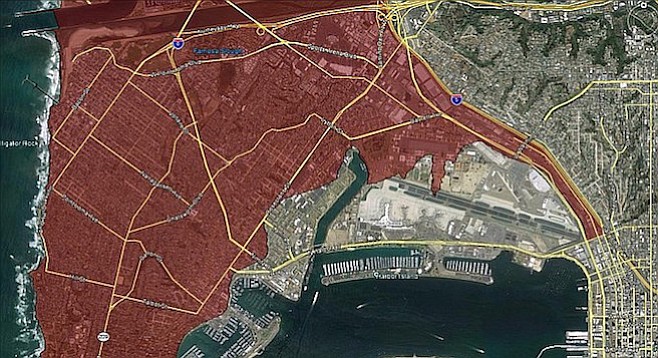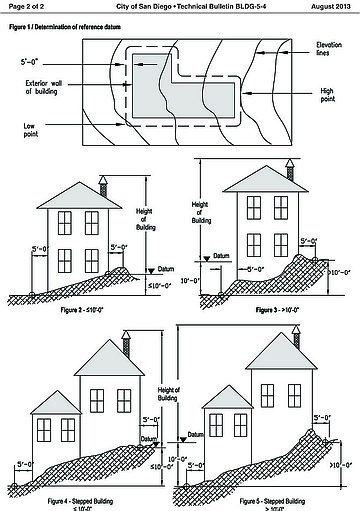 Facebook
Facebook
 X
X
 Instagram
Instagram
 TikTok
TikTok
 Youtube
Youtube

On October 24, the city council voted 7-1 in favor of amending the Land Development Code to get developers in line with the intent of 1972's Proposition D. The amendment will take the form of a footnote added to Section 131.0431, spelling out that no residential multi-family structures are allowed to be taller than 30 feet within Point Loma’s coastal overlay zone.
Councilmember David Alvarez was the dissenting vote (councilmember Scott Sherman was absent). After questioning Development Services Department director Robert Vacchi and a senior planner, Alvarez said, “I still don’t have clarity. I’m not sure if you’re telling me when the 30 foot [limit] applies and when it doesn’t.”
Alvarez wasn’t alone in his confusion, as some of the same questions were asked and answered repeatedly. Councilmember Marti Emerald asked toward the end of the hearing if they were on solid legal ground in changing a ballot measure (Prop D). The city attorney’s office clarified that this amendment was in no way changing Proposition D.
The impetus for this amendment began in June when the Point Loma community fought back when four four-story condos went up in a residential neighborhood (Emerson and Evergreen streets) where a one-story house once stood. The builder had brought in dirt to create a new grade from which to measure the height. Protests, public meetings, and closed-door meetings with the mayor's office followed.
Four people spoke out in opposition to the amendment at last week's hearing. One person said he was in favor of the amendment but wanted to make clear two things: letting builders fake the grade in Point Loma was “illegal” and it was “a mistake made by the Development Services Department” in collaboration with the city council.
According to Development Services Department planner Raynard Abalos, the ordinance should go into effect before the end of the year for areas outside of the coastal overlay zone in Point Loma. It won't impact anything within the coastal overlay zone until the state coastal commission has its say. The last time the city council voted on how to measure in the coastal overlay zone in 2011, it took the coastal commission two years to certify the update.
“Application of the coastal height limit overlay zone in the Peninsula community plan area has created two separate and distinct height requirements and methods for calculating height," said Abalos. "Structures within the coastal height limit overlay zone must comply with both height requirements. In base zones that allow a height that exceeds 30 feet, the coastal height limit overlay zone allows a project to alter grade, sometimes resulting in a structure that is taller than 30 feet from the existing grade.”
Abalos showed slides while he explained the differences between the two conflicting height requirements: zoning requires that height be measured from the existing grade or lower proposed grade; coastal height is measured from the finished (higher) grade. In other words, builders are required to not manipulate the grade while simultaneously being allowed to manipulate the grade.
At the hearing, Vacchi placed most of the blame for grade manipulation at the feet of Proposition D and how it dictates that structures be measured from the finished grade instead of the lower existing grade. This is in line with the technical bulletin that his department put out in 2013 to clarify how to measure height in the coastal overlay zone — by measuring from the finished grade instead of the lower existing grade.

Both Gloria and Lightner requested that city staff come back soon with a remedy to help other similarly impacted communities. Vacchi said that he will be coming back to the city council in July 2017 with a more permanent fix in the next land development code update. “It’s way more complicated than I would have thought originally, that’s why it’s going to take us a little bit longer,” said Vacchi.
Don Sevrens from the Peninsula community planning board spoke out at the hearing in favor of the amendment.
After the hearing, I asked Sevrens if he could recall any issues with how buildings were measured before 2013. He said he wasn’t aware of anything. In fact, his group sent a letter to Mayor Faulconer in 2014 about that 2013 technical bulletin with concerns that it was reinterpreting the way structures in the coastal overlay zone were being measured (from existing grade to now finished grade). Faulconer never addressed the planning group's concerns — not until the community demanded it almost two years later.
When asked if they still stand by their 2013 technical bulletin, development services deputy director Elyse Lowe confirmed on October 27, “We stand by our bulletin. Nothing was changed or reinterpreted in 2013.”


On October 24, the city council voted 7-1 in favor of amending the Land Development Code to get developers in line with the intent of 1972's Proposition D. The amendment will take the form of a footnote added to Section 131.0431, spelling out that no residential multi-family structures are allowed to be taller than 30 feet within Point Loma’s coastal overlay zone.
Councilmember David Alvarez was the dissenting vote (councilmember Scott Sherman was absent). After questioning Development Services Department director Robert Vacchi and a senior planner, Alvarez said, “I still don’t have clarity. I’m not sure if you’re telling me when the 30 foot [limit] applies and when it doesn’t.”
Alvarez wasn’t alone in his confusion, as some of the same questions were asked and answered repeatedly. Councilmember Marti Emerald asked toward the end of the hearing if they were on solid legal ground in changing a ballot measure (Prop D). The city attorney’s office clarified that this amendment was in no way changing Proposition D.
The impetus for this amendment began in June when the Point Loma community fought back when four four-story condos went up in a residential neighborhood (Emerson and Evergreen streets) where a one-story house once stood. The builder had brought in dirt to create a new grade from which to measure the height. Protests, public meetings, and closed-door meetings with the mayor's office followed.
Four people spoke out in opposition to the amendment at last week's hearing. One person said he was in favor of the amendment but wanted to make clear two things: letting builders fake the grade in Point Loma was “illegal” and it was “a mistake made by the Development Services Department” in collaboration with the city council.
According to Development Services Department planner Raynard Abalos, the ordinance should go into effect before the end of the year for areas outside of the coastal overlay zone in Point Loma. It won't impact anything within the coastal overlay zone until the state coastal commission has its say. The last time the city council voted on how to measure in the coastal overlay zone in 2011, it took the coastal commission two years to certify the update.
“Application of the coastal height limit overlay zone in the Peninsula community plan area has created two separate and distinct height requirements and methods for calculating height," said Abalos. "Structures within the coastal height limit overlay zone must comply with both height requirements. In base zones that allow a height that exceeds 30 feet, the coastal height limit overlay zone allows a project to alter grade, sometimes resulting in a structure that is taller than 30 feet from the existing grade.”
Abalos showed slides while he explained the differences between the two conflicting height requirements: zoning requires that height be measured from the existing grade or lower proposed grade; coastal height is measured from the finished (higher) grade. In other words, builders are required to not manipulate the grade while simultaneously being allowed to manipulate the grade.
At the hearing, Vacchi placed most of the blame for grade manipulation at the feet of Proposition D and how it dictates that structures be measured from the finished grade instead of the lower existing grade. This is in line with the technical bulletin that his department put out in 2013 to clarify how to measure height in the coastal overlay zone — by measuring from the finished grade instead of the lower existing grade.

Both Gloria and Lightner requested that city staff come back soon with a remedy to help other similarly impacted communities. Vacchi said that he will be coming back to the city council in July 2017 with a more permanent fix in the next land development code update. “It’s way more complicated than I would have thought originally, that’s why it’s going to take us a little bit longer,” said Vacchi.
Don Sevrens from the Peninsula community planning board spoke out at the hearing in favor of the amendment.
After the hearing, I asked Sevrens if he could recall any issues with how buildings were measured before 2013. He said he wasn’t aware of anything. In fact, his group sent a letter to Mayor Faulconer in 2014 about that 2013 technical bulletin with concerns that it was reinterpreting the way structures in the coastal overlay zone were being measured (from existing grade to now finished grade). Faulconer never addressed the planning group's concerns — not until the community demanded it almost two years later.
When asked if they still stand by their 2013 technical bulletin, development services deputy director Elyse Lowe confirmed on October 27, “We stand by our bulletin. Nothing was changed or reinterpreted in 2013.”
Comments